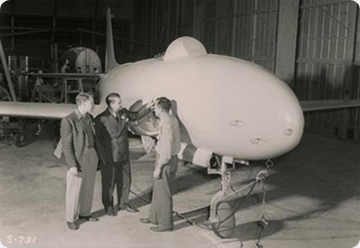HISTORY OF THE JETSTAR
"Legendary" is the only word for the Jetstar. It was designed by the celebrated Lockheed Skunk Works in the late 1950s, which was at the time under the incredibly intuitive genius of Kelly Johnson. Johnson was the brains behind many aircraft, from the P-80 Shooting Star to the U-2 spy plane, as well as the awesome A-12, which in turn morphed into the incredible SR-71 Blackbird. These planes were all designed before computers and all work was done on a blackboard and with a slide ruler.
When Kelly got the 'go ahead' on the Jetstar, the story goes, he wrote down that day the first flight would be 8 months away, to the day - and it did fly on that designated day, as promised. The plane was designed with every back-up system of a Boeing 707 and the initial pilot training took 6 months to teach them to think fast enough and far enough ahead in anticipation of the plane's needed inputs.
The aircraft's original purpose was to compete in a competition to provide a general Utility Transport Category plane for the Air Force. The two aircraft that made the final grade were the two-engine versions of the Jetstar from Lockheed and the Saberliner from North American. The Jetstar was the choice by the Air Force. Meanwhile, the Kennedy White House was looking for Presidential/VIP transport to augment the first 707s that were being used as Air Force One aircraft, and they contacted Lockheed asking if the Jetstar could be re-configured as a four-engine aircraft. Lockheed turned to Pratt & Whitney Aircraft Engines about replacing the two French-built Orpheus engines on the original design with four Pratt & Whitney engines and the plane was re-engineered to its current design, adding slipper tanks on the wings for extra fuel and range.
However, there is another side to the Jetstar: its commercial history. Of the 206 Jetstars built, only 15 or so were actually delivered to the Air Force inventory. The rest were purchased by individuals and corporations who needed trans-continental and trans-oceanic transportation. The earliest planes went to the likes of the Vanderbilts, the Shah of Iran, the legendary Elvis Presley and a myriad of Fortune 500 companies (Howard Hughes had four of them through his Summa Corporation).
The aircraft went through 3 engine up-grades in its history, each of which added to its range, reliability and legend. Going on over 50 years later, there are still over 80 of the planes in use by high net-worth individuals, corporations, and several governments around the world. In addition, to date, no Jetstar has ever gone down due to component failure. Lockheed estimates that half of the planes today are used by people who still do not trust two-engine aircrafts - even if they like the ultra-modern and state-of-the-art Gulfstream.
When Kelly got the 'go ahead' on the Jetstar, the story goes, he wrote down that day the first flight would be 8 months away, to the day - and it did fly on that designated day, as promised. The plane was designed with every back-up system of a Boeing 707 and the initial pilot training took 6 months to teach them to think fast enough and far enough ahead in anticipation of the plane's needed inputs.
The aircraft's original purpose was to compete in a competition to provide a general Utility Transport Category plane for the Air Force. The two aircraft that made the final grade were the two-engine versions of the Jetstar from Lockheed and the Saberliner from North American. The Jetstar was the choice by the Air Force. Meanwhile, the Kennedy White House was looking for Presidential/VIP transport to augment the first 707s that were being used as Air Force One aircraft, and they contacted Lockheed asking if the Jetstar could be re-configured as a four-engine aircraft. Lockheed turned to Pratt & Whitney Aircraft Engines about replacing the two French-built Orpheus engines on the original design with four Pratt & Whitney engines and the plane was re-engineered to its current design, adding slipper tanks on the wings for extra fuel and range.
However, there is another side to the Jetstar: its commercial history. Of the 206 Jetstars built, only 15 or so were actually delivered to the Air Force inventory. The rest were purchased by individuals and corporations who needed trans-continental and trans-oceanic transportation. The earliest planes went to the likes of the Vanderbilts, the Shah of Iran, the legendary Elvis Presley and a myriad of Fortune 500 companies (Howard Hughes had four of them through his Summa Corporation).
The aircraft went through 3 engine up-grades in its history, each of which added to its range, reliability and legend. Going on over 50 years later, there are still over 80 of the planes in use by high net-worth individuals, corporations, and several governments around the world. In addition, to date, no Jetstar has ever gone down due to component failure. Lockheed estimates that half of the planes today are used by people who still do not trust two-engine aircrafts - even if they like the ultra-modern and state-of-the-art Gulfstream.
Back to About Us

